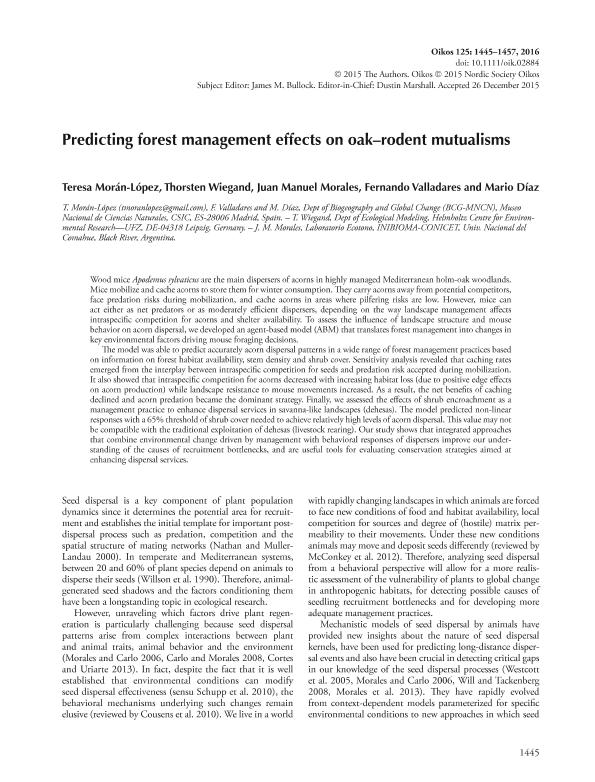Artículo
Predicting forest management effects on oak–rodent mutualisms
Fecha de publicación:
30/10/2016
Editorial:
Wiley Blackwell Publishing, Inc
Revista:
Oikos
ISSN:
0030-1299
Idioma:
Inglés
Tipo de recurso:
Artículo publicado
Clasificación temática:
Resumen
Wood mice Apodemus sylvaticus are the main dispersers of acorns in highly managed Mediterranean holm-oak woodlands. Mice mobilize and cache acorns to store them for winter consumption. They carry acorns away from potential competitors, face predation risks during mobilization, and cache acorns in areas where pilfering risks are low. However, mice can act either as net predators or as moderately efficient dispersers, depending on the way landscape management affects intraspecific competition for acorns and shelter availability. To assess the influence of landscape structure and mouse behavior on acorn dispersal, we developed an agent-based model (ABM) that translates forest management into changes in key environmental factors driving mouse foraging decisions. The model was able to predict accurately acorn dispersal patterns in a wide range of forest management practices based on information on forest habitat availability, stem density and shrub cover. Sensitivity analysis revealed that caching rates emerged from the interplay between intraspecific competition for seeds and predation risk accepted during mobilization. It also showed that intraspecific competition for acorns decreased with increasing habitat loss (due to positive edge effects on acorn production) while landscape resistance to mouse movements increased. As a result, the net benefits of caching declined and acorn predation became the dominant strategy. Finally, we assessed the effects of shrub encroachment as a management practice to enhance dispersal services in savanna-like landscapes (dehesas). The model predicted non-linear responses with a 65% threshold of shrub cover needed to achieve relatively high levels of acorn dispersal. This value may not be compatible with the traditional exploitation of dehesas (livestock rearing). Our study shows that integrated approaches that combine environmental change driven by management with behavioral responses of dispersers improve our understanding of the causes of recruitment bottlenecks, and are useful tools for evaluating conservation strategies aimed at enhancing dispersal services.
Palabras clave:
Acorn Dispersal
,
Forest Management
,
Agent Based Model
Archivos asociados
Licencia
Identificadores
Colecciones
Articulos(INIBIOMA)
Articulos de INST. DE INVEST.EN BIODIVERSIDAD Y MEDIOAMBIENTE
Articulos de INST. DE INVEST.EN BIODIVERSIDAD Y MEDIOAMBIENTE
Citación
Morán López, Teresa; Wiegand, Thorsten; Morales, Juan Manuel; Valladares, Fernando; Díaz, Mario; Predicting forest management effects on oak–rodent mutualisms; Wiley Blackwell Publishing, Inc; Oikos; 125; 10; 30-10-2016; 1445-1457
Compartir
Altmétricas




